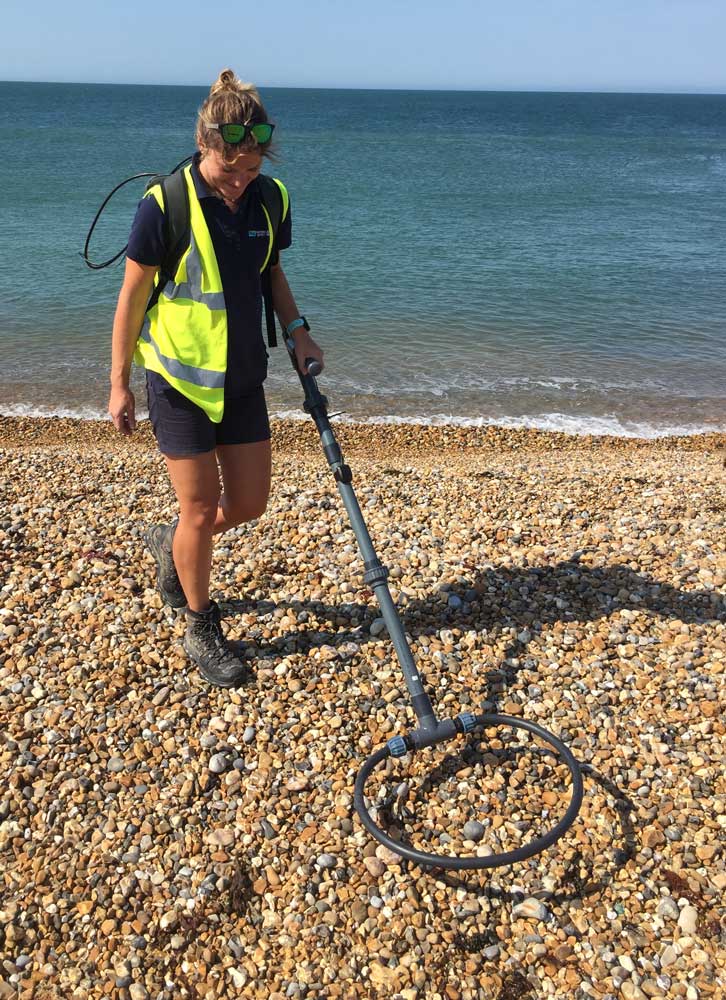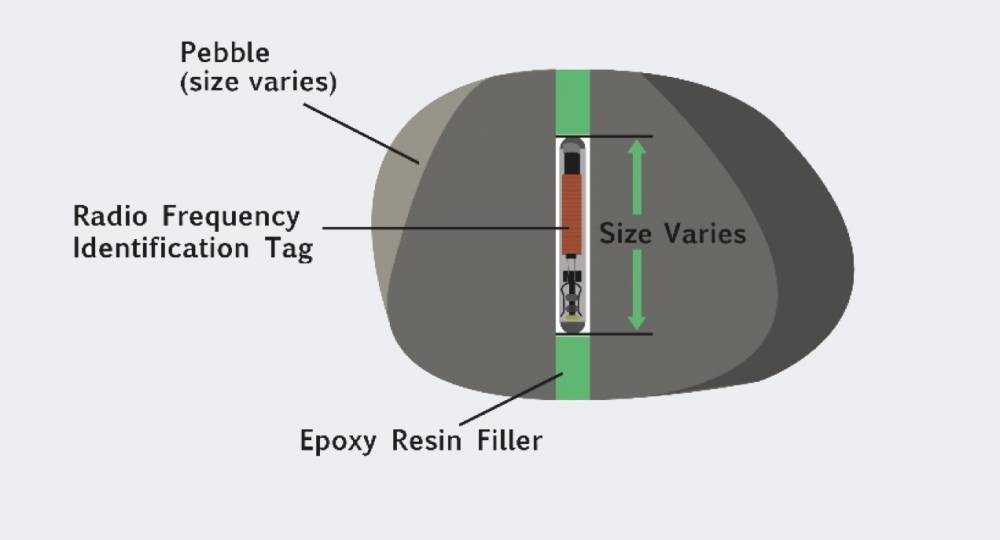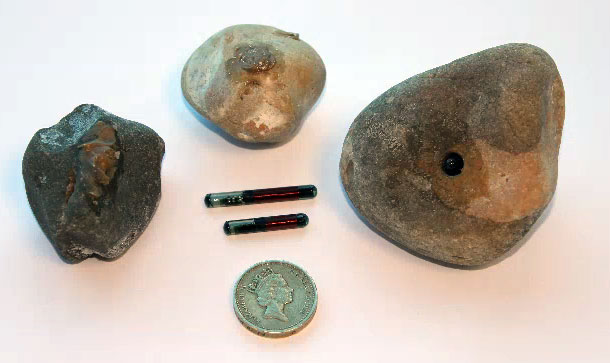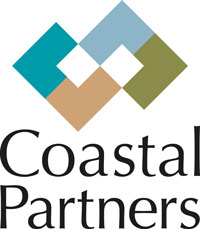Tracer Pebble Studies
Tracking the movement of coarse sediment along beaches

The team at Coastal Partners has developed an innovative method of utilising radio-frequency identification (RFID) technology to track the movement of material along coarse sediment beach frontages:
“By deploying and tracking these pebbles, we are able to collect valuable information on rates, direction and the patterns of littoral drift within an area of interest. This helps us to better understand local coastal processes, which in turn, supports local coastal management decisions, aids coastal defence scheme design and informs local beach maintenance activities, such as recycling and replenishment campaigns.”
The use of Tracer Pebbles as a method of measuring longshore sediment transport has been widely used and reported on in the coastal environment. Early methods of tracking beach sediment included using fluorescent material, resin shapes and copper cores and aluminium pebbles. More recently, the Radio Frequency Identification (RFID) technology has been used to accurately and efficiently monitor this movement.

The system comprises three main components; passive induced transponder (PIT) tags which broadcast a unique ID number when detected; an antenna used to scan the beach and a data logger used to store the ID number and recorded location.
The studies
In addition to the projects that have previously been carried out within East Solent, the SCG and SCOPAC has been coordinating a number of Tracer Pebble projects across the region.
The aim of these studies is to build a database of information on the discrete sediment transport pathways at selected sites along the south coast, as well as validating the detailed knowledge that has previously been presented through projects such as the Sediment Transport Studies (SCOPAC, 2004; 2012).
Studies documented on this website:
- East Solent Phase I (2011) – at Eastoke, Langstone Harbour entrance and Southsea Memorial
- East Solent Phase II (2013) – at Solent Breezes, Lee-on-Solent and Stokes Bay
- Preston Beach, Weymouth (2018-2020) – to better understand the complex coastal processes around Preston Beach
- Langstone Harbour entrance (2018-2020) – to track the movement of beach material around Eastney Spit
- West Beach & East Beach, West Bay (2021-2022) – to provide an improved understanding of sediment transport pathways along the West Bay shoreline to inform future beach management operations
Outputs from the studies, in combination with data from the National Network of Regional Monitoring Programmes, help to advance the understanding of local coastal processes by providing quantitative information such as sediment transport rates and directions. This information informs Flood and Coastal Erosion Risk Management at an operational level, scheme design and at a strategic level, feeding into updates of the SCOPAC Sediment Transport Studies.
How they work
Small Radio Frequency Identification (RFID) tags are embedded within native pebbles collected from a site of interest and secured with a waterproof resin.
The RFID tags store a unique ID number which is logged, together with the GPS location by the specialist equipment during the retrieval surveys. The tags used are passive, meaning that they have no internal power source and can remain in situ for extended periods.
The pebbles are then deployed and re-surveyed at set intervals using a specialised scanner and a Global Positioning System (GPS).

Figure 1: Example of the range of Tracer Pebble sizes and the RFID tags.
How we survey the beach
We walk the beach with handheld antennas using one, or several surveyors, depending on the size of the beach to cover. The surveyors will sweep the beach in a linear pattern between mean low water spring (MLWS) and the beach crest. It may be necessary to include the back of the beach if there has been a particularly strong storm event causing overtopping and overwash.
The equipment will make an audible noise when a tag has been detected and will automatically log the tag number together with the GPS location. This means that we do not need to stop and obtain a visual identification of the pebble, however this can be done at a later date if further information on attrition rates is required.
Surveying the beach at Hayling Island
Why are tracers needed?
The data collected has proven to be extremely useful, particularly for dynamic or highly managed beaches where elevation difference plots or aerial photography are not sufficient to identify net sediment movement following replenishment or recycling activities.
Coastal Partners has successfully applied the method in conjunction with topographic data to understand how quickly and how far replenished material moves downdrift. Overlaying Tracer Pebble results onto a topographic difference plot for example, helps to visualise the discrete pathways which confirms the direction in which eroded material travels (during the period of the retrieval surveys). These results have helped to confirm the location of drift divides; convergence zones and net sediment drift patterns.
Figure 2: Topographic difference plot, showing the changes in beach levels between 2004 and 2016. The red colour shows where the beach has lowered (erosion) and blue indicates areas that have built up (accretion)
Key Facts
- The tracers are not visible to the naked eye and therefore are less prone to disturbance from beach users;
- The tracer tags use no power and can be left in the field for long periods of time;
- The vertical detection range of the antenna can be up to 1m, which enables buried Tracer Pebbles to be identified;
- After initial deployment a number of retrieval surveys are conducted over a period of weeks, months and years to allow long-term trends in sediment pathways to be identified;
- Average detection rates over a two-week period are approximately 72%, with more than 95% of all tags being detected more than once;
- After 5 months in the field tracers can disperse along 3 kilometres of beach.
How could this Tracer Pebble method help you?
- The method can help to highlight the local scale sediment transport pathways which directly affect the movement of material along the beach frontage;
- The results provide a powerful tool to aid Beach Management Plans and the location of beach control structures;
- Clearly presented results are a powerful tool for explaining sediment transport to council members and the general public;
- The results have already proved useful in discussions with various stakeholders around the frontage, and the study has received widespread support and interest from Councillors and the public alike.

Sacha Neill and Dr Samantha Cope, together with the Countryfile production team including presenter Ellie Harrison
Tracer Pebbles find fame on Countryfile!
The innovative design and use of Coastal Partners’ tracer pebbles caught the eye of BBC One’s flagship show Countryfile in 2018.
Coastal engineers Sacha Neill and Dr Samantha Cope met presenter Ellie Harrison on Hayling Island, where they demonstrated how the tracer pebbles help to build an understanding of longshore drift patterns along Hayling beach frontage. The programme aired in May that year.

Further Information
There is growing interest in this method of Tracer Pebble survey, with future deployments along the south coast of England being co-ordinated by the SCG and SCOPAC .
If you are interested in using this method on your beaches, please contact the Coastal Partners at coastal.team@havant.gov.uk


